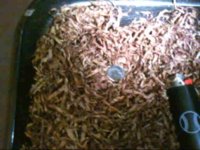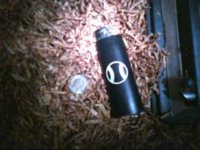Hi guys
Am not a grower but will do my first this coming spring I need to know so much more about tobacco. I have been playing around with VA Bright and 2 types of burly had a great tasting mix kind of earthy / nutty and smooth than lost it. Did not change any thing, I think it is due to misting and storing. Any way it lead me to this thread while searching for more info. I found an interesting site and thought I would share it below is a bit of what I read there and may be of help for others visiting or members of this forum.
The link to the site is at the bottom
According to literature on the subject (16,17) su ar was.introduced into U. S. blended cigarettes in 19]3 as a result of a decline in chewing tobacco manufacturiug, utilizing essentially the same tobacco-casing formulation. The resuiting taste was instantly accepted by the American public. The types and;amounts of various su ars added to tobacco blends will vary from manufacturer to manufacturer and from blend to blend. According to Abdallah (3), the type and amount of added su ar plays a dominant role in the smoking quality of the blend. Indeed, Shmuk (1.8) is said to have demonstrated that the quality of tobacco varies in direct relation to soluble su ars and in inverse relationship to proteins contained in the cured and aged or fermented leaf. Abdallah (3) has stated that "two impo rtant sweetening agents in cigarette manufacture in the.United States are maple sugar and honey, which are both used - in saucing or ca_ sing of cigarette tobaccos because of the particular aroma they impart to fresh cigarettes and cigarette smoke. Licorice has been used extensively and it is considered as a possible competitor to sucrose in cigarette manufacture." Experiments have also been carried out (19) on the evaluation of high- flavored maple sugar as a casing agent in cigarette tobaccos. Needless to say, the casing and flavoring agents used by manufacturers vary widely and the formulae are closely guarded secrets. One of the reasons advanced (3,18) for separately casing burley tobacco is to achieve a balance of sugars in the blend since burley tobacco contains little, if any, sugar. The effect of the addition of sugar and humectants on the filling power of burley tobacco is shown in Figures 35C.1 and 35C.3, but an even more drastic loss in filling power with sugar addition is experienced with application to Turkish (oriental) or flue-cured tobacco. An example of the effect of the addition of casing sugar (invert) solution on the filling power of blended Turkish leaf is shown in Figure 34C.1 (10). This loss in filling power, is so great that most of the casing su ars are applied to burley tobacco. on 0 0) cn N w cn 0 0
Experiments have been conducted (20) to determine the uniformity of su ar distribution when the su ar is'applied to burley tobacco which, initially, ~ contains no sugar. Even under optimum conditions, it was found that different 'parts-of-the strip evidently have different-absorpfT,)n'capacities. This was determined by chemical analysis of various screen fractions of the cased burley. The results are Shown as Figure 34C.2. The suGar content was found to decrease as strand length'increased. The filling power increased, as expected, with increased strand length. By way of summary: (a) Humectants are added to retard the rate of gain or loss of moisture from the tobacco blend, (b) Sugars are added to achieve a "sugar balance" between burley and flue-cured tobacco, (c) Both humectants and su ars are added to improve tobacco smoking quality and to improve the shelf- life of the product, (d) Both are added to lubricate the tobacco so that it may cut more easily without•shattering, and (e) The addition of both humectants and su ars causes a loss of filling power of the blend which, i.n the case of burley tobacco, may be partially offset by roasting the tobacco. I i
http://tobaccodocuments.org/rjr/506523494-3505.html
I off to buy some tubs to case my Burley




